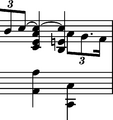



Pitch
|
b. 10
|
composition: Op. 49, Fantaisie in F minor
..
For the 3rd crotchet in the bar we choose the unquestionable A version (→GE). The same version, although written down with errors, is to be seen in FE1. The mistakes were corrected in FE2, yet, according to us, another mistake was committed in the act – the topmost note was changed from a category imprint: Interpretations within context; Differences between sources; Corrections & alterations issues: EE revisions , Errors in FE , Errors resulting from corrections , Terzverschreibung error , Annotations in FES , Authentic corrections of FE , Authentic post-publication changes and variants , Annotations in FEJ , FE revisions |
||||||||||
|
b. 15-16
|
composition: Op. 49, Fantaisie in F minor
..
In FCs these bars are written in shorthand as empty bars marked with digits 1 and 2, whereby in bar 16 digit 2 is followed by a C
The first two possibilities give the same result, compliant with the published version, in which the L.H. part is devoid of octave doublings. On the other hand, the third interpretation leads to a version featuring octaves, which we suggest in the main text – see the note below. category imprint: Interpretations within context; Source & stylistic information |
||||||||||
|
b. 15-16
|
composition: Op. 49, Fantaisie in F minor
..
It seems highly likely that Chopin did not repeat the L.H. octave doublings in these bars – cf. bars 11-12 – only due to the fact that the pianos at his disposal did not include C category imprint: Editorial revisions issues: Bass register changes |
||||||||||
|
b. 17
|
composition: Op. 49, Fantaisie in F minor
..
In A and FE the category imprint: Interpretations within context; Differences between sources issues: EE revisions , Accidentals in different octaves , GE revisions , Inaccuracies in A , Errors repeated in FE |
||||||||||
|
b. 18
|
composition: Op. 49, Fantaisie in F minor
..
In FE1 the topmost note of the arpeggiated chord on the 3rd beat is preceded by a category imprint: Interpretations within context; Differences between sources; Source & stylistic information issues: EE revisions , Errors in FE , Authentic corrections of FE , FE revisions |

 1 in
1 in 
 minor, Op. 39,
minor, Op. 39,  raising g2 to g
raising g2 to g (c3). The manifest error was corrected – perhaps at Chopin's request – in
(c3). The manifest error was corrected – perhaps at Chopin's request – in